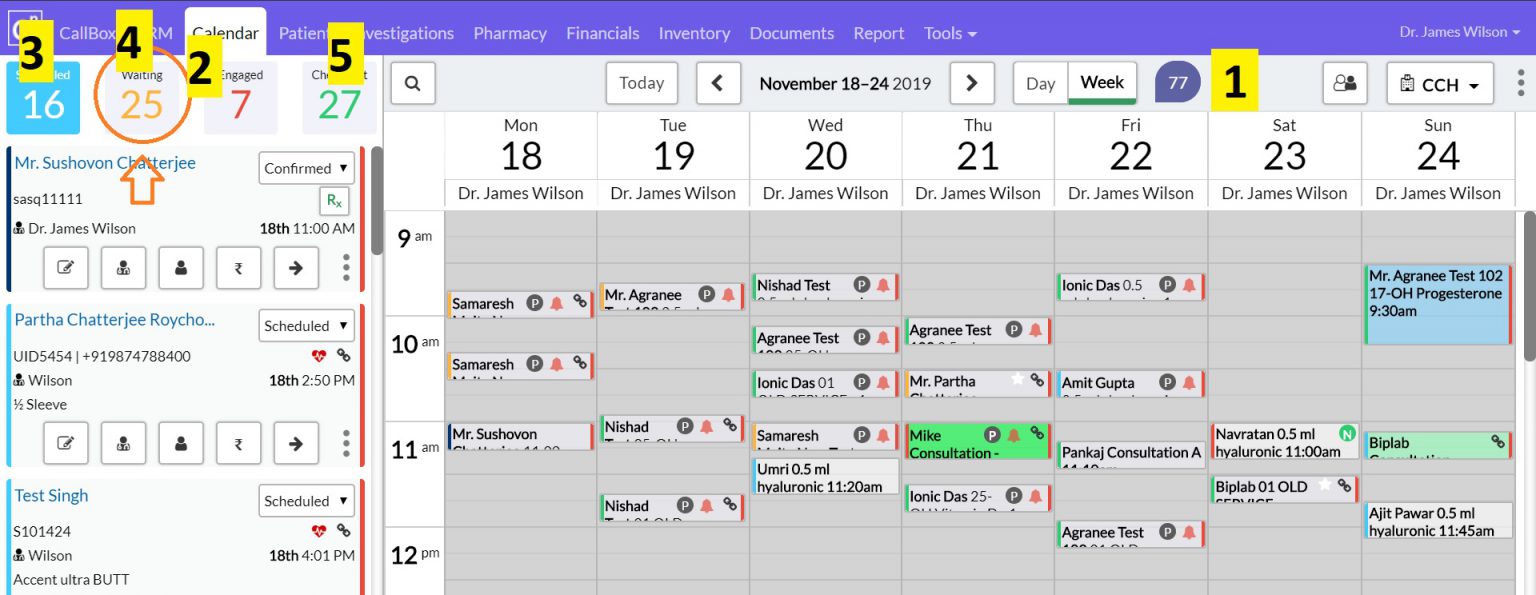‘First impression is often the last impression’ – surely you have heard that one before. For your practice, that makes your “Waiting Room” the first touch point, the first impression before your Patients. Let us see the basic challenges faced while managing a Waiting room and how we can overcome them with the help of a well-designed Practice Management System.
1. Is your Scheduler designed for a Medical Clinic
Any clinic that you can think of now, use some form of automation for their daily operations, and the must for each clinic is a “Calendar” or “Scheduler”. At a glance, most calendars look the same. They show you all the appointments for the day, what time each starts, who it is for, the current appointment status etc. Here is a typical looking Calendar screen from a software
Looks nice. But is that enough? Look at it again and this time let’s see if the most common tasks of the front desk staff can be done easily off that screen:
- How many Patients are scheduled to come in?
- How many have come in and are waiting?
- Has anyone been waiting for far too long and is getting frustrated?
- What does the remainder of the day look like, and how many more are yet to come in?
- How many have come and left already?
If in order to answer any of these questions you have to check your appointments carefully one at a time, it will take forever, and really is it any different from using pen and paper to run your clinic?
Now let us look at another hypothetical Calendar, this time designed for a Medical Clinic, with the functions of the front desk staff right at the forefront.

- How many Patients are scheduled to come in? Look at option 1
- How many have come in and are waiting? 25. Look at option 2
- Has anyone been waiting for far too long and is getting frustrated? Look at option 2. Next to each appointment in waiting time, you will see how long each patient has been waiting.
- What does the remainder of the day look like, and how many more are yet to come in? Look at option 3.
- How many have come and left already? Look at option 5
If we scratch the surface, there will be more relevant questions.
- How many are done with the consultation and are waiting for Billing to be completed?
- How many are waiting for the pharmacist to dispense before they can leave the clinic?
- Which patients are waiting for the Lab Technician to collect blood-work samples?
And if we do some research before committing to software for the Clinic, we will find all of these questions will be super easy to answer. For the simple reason, that the team building such a system would have gone through the common functions of the front desk of the clinic and built their system such, that these questions can be answered right off the bat.
2. One patient has multiple Appointments
Another most common hurdle that one faces is when a patient is having multiple appointments on a single day for various services offered by the clinic. Usually, appointments are booked against each of the services and when the patient arrives at the clinic, the front desk checks in the patient for the first appointment. What happens to the other appointments? Most systems will leave the other appointments as scheduled unless manually changed one after the other. And in case, if this is missed, then the patient is waiting in the waiting room for their next appointment and is frustrated about the time being wasted waiting. This is bound to leave a bad experience.
An ideal Practice Management software does not leave this to chance. Once you check in the first appointment for a patient who has multiple appointments, the remaining appointments are also automatically checked in. It does not leave the scope of a human error and ensures your front desk is not made busy with tasks that could be well left automated.
3. Wait Times
The last and perhaps the most important issue when managing your waiting room is the wait time itself.
“How do you find out how long has the patient been waiting?”
Even though your appointments are scheduled for a specific time period, you can never guarantee that it gets over within that time period. Thus a single appointment extending beyond the specified time would automatically delay the next appointment and the next. Hence it is very important to know who has been waiting and for how long. Having a system in place which tells you exactly this, goes a long way in avoiding any escalation and attending to such a patient who has been waiting for a long time. This way the patient does not feel forgotten or less valued.
A smart system does that by highlighting those appointments where the patient has waited beyond a threshold as specified by the clinic. It gives the front desk a chance to acknowledge such a wait, prioritize them, reschedule things, – do something proactively as opposed to making the patient feel, that the clinic is indifferent to his time, and to his wait. Before the situation gets out of hand, you can do something about it, and a smart system will help you identify this amidst the rigours of running a busy practice.

I love writing, especially about health tech :). Feel free to reach out to me with your comments and feedback at rachanas@emrmagazine.com